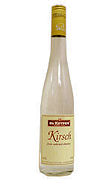The Cheese and Wine Shop Glossary ...
looking for some quirky lowdown, or an answer to an elusive question, then The Cheese and Wine Shops glossary is a good place to start ... (awaiting updates)
A B C D E F G H I J K L M N O P Q R S T U V W X Y ZE Central Europeans have been distilling fruits for centuries, creating an outstanding array of eaux-de-vie of cherries, pears, apples, strawberries, raspberries, blueberries, apricots and plums, to name just a few.
Fruit eaux-de-vie are derived from perfectly ripe fruit that has been fermented and distilled. Quality eaux-de-vie are clear, with an intense nose and palate evocative of the base fruit. They are always dry, smooth and well rounded to provide maximum satisfaction. They should be served in snifters to appreciate their distinct aroma and should be chilled but never iced. They can be poured into coffee, or even be mixed in pastries as Normans do, and they are delicous as a base when introducing fruit flavours to Chocolate Truffles.
Italians distil grappa from wine pomace. Grappa today is a sophisticated and smooth product often distilled from Moscato or Nebbiolo pomace, but also from Riesling, Chardonnay, Cabernet Sauvignon and even icewine. Marc is the French term for grappa and Burgundians, Champagnards and Bordelais all have their versions. In Charente Maritime they produce Pineau de Charente where to 2/3 grape juice 1/3 marc is added; this makes a refreshing aperitif. In Champagne they do the same with their marc and grape juice.
Austrians and Germans produce some fine apricot eaux-de-vie, but are perhaps most famous for their Kirsch eau de vie. French, Spaniards, and north Italians also produce this heavenly distillate, but its for the most part best known by its German name.
In Switzerland cherries grow practically in all cantons but in particular Schwyz, Uri, Luzern, Vaud, Valais, Geneva, Bern, Basel produce fine kirsch. In Switzerland people enjoy kirsch in their coffee, on its own, after a festive meal, and in cakes.
 Buy Kirsch from The Cheese and Wine Shop; perfect for cocktails and cuisine!
Buy Kirsch from The Cheese and Wine Shop; perfect for cocktails and cuisine!
Poire Williams is widely known, and is a pear eaux-de-vie, and is excellent on its own, in coffees, fruit salads, pastries, and even as a stomach settling medication after a particularly "greasy" meal. Some distilleries market pear brandy with a pear in the bottle. Growing the pear in the bottle is a laborious and costly process and such products command a high price. See our Somerset Cider Brandys Eaux-die-vie for our local version.
Berries (strawberries, raspberries, blueberries) are often used for eau de vie . Alsatians, Swiss, Austrians and Germans produce particularly flavourful and smooth berry distillates. In Slavic countries plum brandy generically is called Slivovic.
 Buy Slivovic, or as its otherwise known, "Sliwowica" here at The Cheese and Wine Shop.
Buy Slivovic, or as its otherwise known, "Sliwowica" here at The Cheese and Wine Shop.
Fondue
The word fondue is derived from the French word "fondre" which means "melt".
Fondue Tips ...
Keep the fondue warm over as low heat as possible to avoid scorching the cheese, or overheating the oil.
Make sure your recipe includes a bit of corn starch, all purpose or potato flour. The starch in the flour helps to keep the cheese in suspension which keeps the fondue from separating.
Adding a small amount of lemon juice to the wine increases acidity which in turn helps to break up the cheese.
When you add the cheese to the simmering wine, stir in a zig zag rather than circular motion to help break up the cheese.
Burgundy "Marcs" enjoy the reputation conferred on them by the great Burgundy wines from which they are made but also from an "Appellation Réglementée" (Controlled product definition). The grape skins are carefully removed and then the Marcs are aged in oak barrels before being harmoniously blended according to their age and origin. This produces grape brandies of great finesse and distinctive character.
Marc de Champagne is an Eau de vie obtained by distilling fermented and stemmed grapes which come exclusively from the Champagne region. After distillation the spirit is aged in oak casks and reduced to an alcoholic strength of 40%. In France, it is usually drunk at room temperature, in a round wine glass so that all the subtle and warm flavours can be appreciated. In other countries, such as Spain or Italy, it is often drunk chilled or on the rocks. It is also used as a base in a long drink. You can also use this eau de vie in cooking, to flavour sauces, ice creams, sorbets or even to flambé meat. Buy Marc de Champagne from The Cheese and Wine Shop here! See also Marc de Borgogne here.
Pommace in wine making, is made from the leftover skins and seeds of grapes used for wine. This is called the "Pommacy" or "Pommace". The Pommace is fermented and distilled in its natural state. The result is around 90 proof and clear in color. Grappa, also called “Marc” in France, is perhaps he most widely known drink made in this manner.
Pommace Oil is a low grade oil taken from the final waste pulp. It is mild in flavour, and is generally used for cooking. Olive-Pomace Oil is a blend of refined olive-pomace oil and virgin olive oil fit for consumption as is. Once again, however, in no event whatsoever may it be called "olive oil" according to the International Olive Oil Council rules.
.











